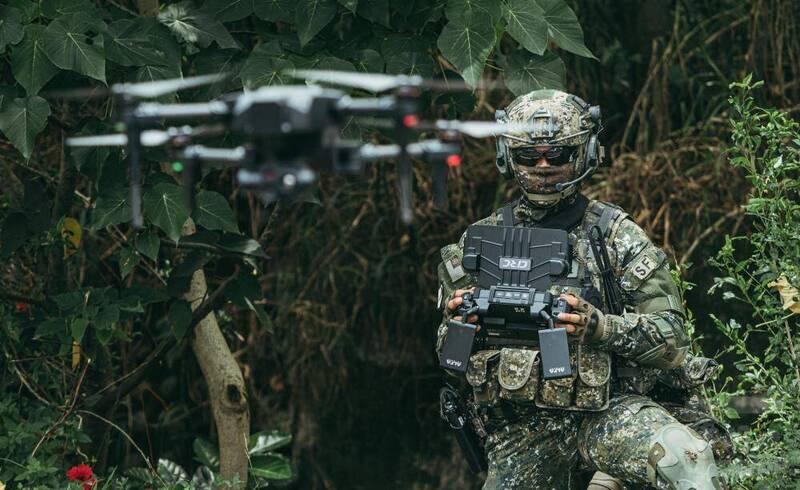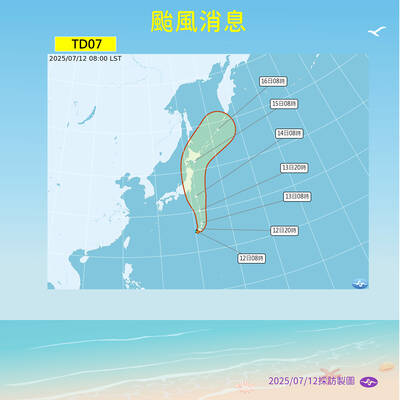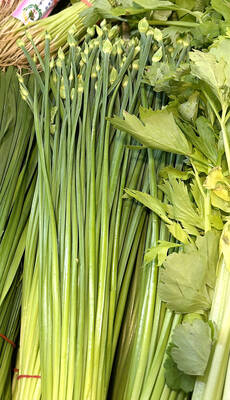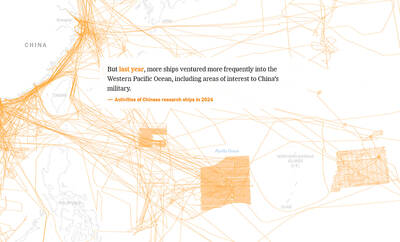Several newly deployed micro surveillance and reconnaissance drones have made their debut in the Han Kuang military exercises, Taiwan's military media reported yesterday.
Military quadcopters have been deployed during the Han Kuang exercises, running from July 9 through today. The Army uses them for reconnaissance and surveillance, the Navy for escorting minelaying missions and the Air Force to assist air defense, according to a Military News Agency (MNA) report released yesterday.
According to budget proposals from the Ministry of National Defense (MND), Taiwan's armed forces have allocated NT$1.28 billion (US$43.68 million) for last year and this year to purchase 1,458 domestically produced micro surveillance and reconnaissance drones.

Photo courtesy of the Military News Agency
Also yesterday, a separate MNA report said Taiwan's Marine Corps 99th Brigade, originally based in southern Kaohsiung City, entered the Greater Taipei area and carried out a counterattack drill early that day.
Marine Corps troops drove HUMVEEs equipped with domestically made T-75S 20mm cannons and US-imported MK19 40mm grenade launchers, simulating counterattacks against invading forces and patrolling the area to eliminate remaining threats, according to the MNA report.
According to the MND, this year's 10-day, nine-night Han Kuang exercises are twice as long as previous live-fire drills, which typically lasted five days and four nights.
Since 1984, the annual Han Kuang exercises have been Taiwan's largest war games, combining live-fire drills and tabletop simulations to test combat readiness against a potential Chinese invasion.
This year's tabletop war games were conducted from April 5 to 18.

Tropical Storm Nari is not a threat to Taiwan, based on its positioning and trajectory, the Central Weather Administration (CWA) said yesterday. Nari has strengthened from a tropical depression that was positioned south of Japan, it said. The eye of the storm is about 2,100km east of Taipei, with a north-northeast trajectory moving toward the eastern seaboard of Japan, CWA data showed. Based on its current path, the storm would not affect Taiwan, the agency said.

The Taipei Department of Health’s latest inspection of fresh fruit and vegetables sold in local markets revealed a 25 percent failure rate, with most contraventions involving excessive pesticide residues, while two durians were also found to contain heavy metal cadmium at levels exceeding safety limits. Health Food and Drug Division Director Lin Kuan-chen (林冠蓁) yesterday said the agency routinely conducts inspections of fresh produce sold at traditional markets, supermarkets, hypermarkets, retail outlets and restaurants, testing for pesticide residues and other harmful substances. In its most recent inspection, conducted in May, the department randomly collected 52 samples from various locations, with testing showing

The cosponsors of a new US sanctions package targeting Russia on Thursday briefed European allies and Ukraine on the legislation and said the legislation would also have a deterrent effect on China and curb its ambitions regarding Taiwan. The bill backed by US senators Lindsey Graham and Richard Blumenthal calls for a 500 percent tariff on goods imported from countries that buy Russian oil, gas, uranium and other exports — targeting nations such as China and India, which account for about 70 percent of Russia’s energy trade, the bankroll of much of its war effort. Graham and Blumenthal told The Associated Press

INTEL: China’s ships are mapping strategic ocean floors, including near Guam, which could aid undersea cable targeting and have military applications, a report said China’s oceanographic survey and research ships are collecting data in the Indo-Pacific region — possibly to aid submarine navigation, detect or map undersea cables, and lay naval mines — activities that could have military applications in a conflict with Taiwan or the US, a New York Times report said. The article, titled “China Surveys Seabeds Where Naval Rivals May One Day Clash,” was written by Chris Buckley and published on Thursday. Starboard Maritime Intelligence data revealed that Chinese research ships last year repeatedly scanned the ocean floor east of Taiwan’s maritime border, and about 400km east and west of Guam; “waters that